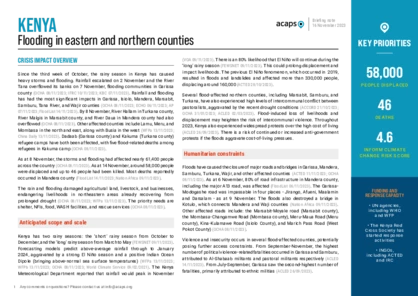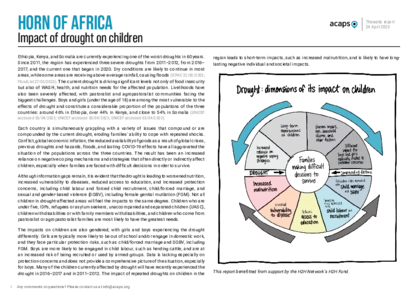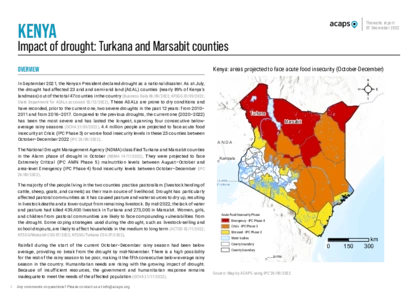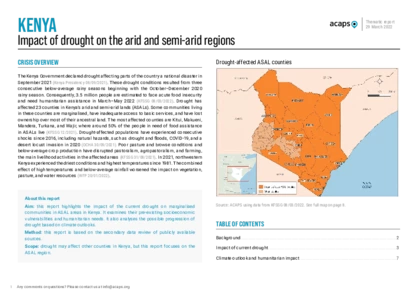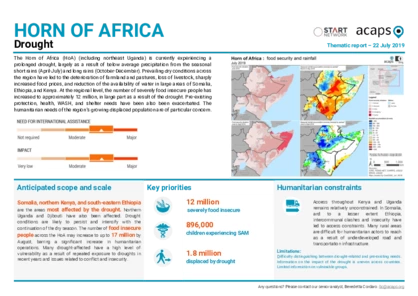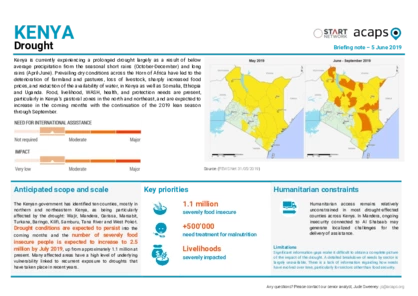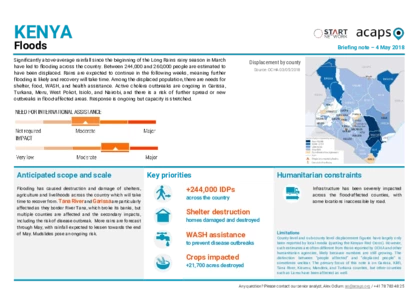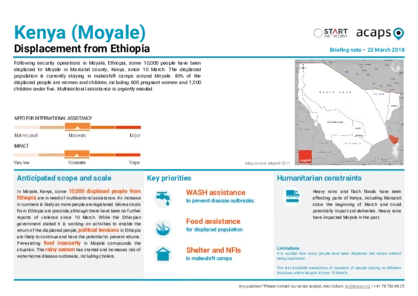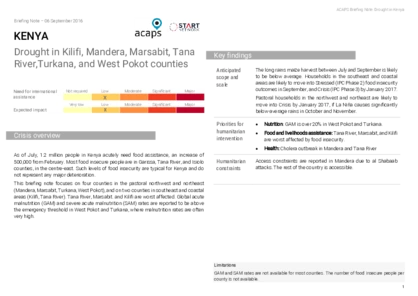Explore our
analysis products
archive
14 May 2024
Kenya: heavy rainfall and floods
DOCUMENT / PDF / 2 MB
Since the start of the March-April-May (MAM) rainy season, Kenya has experienced heavy rainfall, resulting in widespread floods and landslides in various regions. 42 of the country’s 47 counties have been affected by the floods, with Homa Bay, Kajiado, Mandera, Nairobi, and Nakuru being the most severely affected as of 6 May.
16 November 2023
Kenya: flooding in eastern and northern counties
DOCUMENT / PDF / 867 KB
Since the third week of October, the rainy season in Kenya has caused heavy storms and flooding, significantly impacting Garissa, Isiolo, Mandera, Marsabit, Samburu, Tana River, and Wajir counties. As at 8 November, the storms and flooding had affected nearly 61,400 people across the country.
24 April 2023
Horn of Africa: Impact of drought on children
DOCUMENT / PDF / 5 MB
Ethiopia, Kenya, and Somalia are currently experiencing one of the worst droughts in 60 years. The current drought is driving significant levels not only of food insecurity but also of WASH, health, and nutrition needs for the affected population.
07 December 2022
Kenya: impact of drought in Turkana and Marsabit counties
DOCUMENT / PDF / 2 MB
In September 2021, the Kenyan President declared drought as a national disaster. As at July, the drought had affected 23 arid and semi-arid land counties out of the total 47 counties in the country. 4.4 million people are projected to face acute food insecurity at Crisis (IPC Phase 3) or worse food insecurity levels in these 23 counties between October–December 2022.
31 March 2022
Kenya: Impact of drought
DOCUMENT / PDF / 726 KB
This report highlights the impact of the current drought on marginalised communities in Kenya's arid and semi-arid lands. It examines their pre-existing socioeconomic vulnerabilities and humanitarian needs. It also analyses the possible progression of drought based on climate outlooks.
22 July 2019
Horn of Africa: Drought
DOCUMENT / PDF / 830 KB
The Horn of Africa (including northeast Uganda) is currently experiencing a prolonged drought, largely as a result of below average precipitation from the seasonal short rains (April-July) and long rains (October-December). Prevailing dry conditions across the region have led to the deterioration of farmland and pastures, loss of livestock, sharply increased food prices, and reduction of the availability of water in these areas.
05 June 2019
Kenya: Drought
DOCUMENT / PDF / 522 KB
Kenya is currently experiencing a prolonged drought largely as a result of below average precipitation from the seasonal short rains (October-December) and long rains (April-June). Prevailing dry conditions across the Horn of Africa have led to the deterioration of farmland and pastures, loss of livestock, sharply increased food prices, and reduction of the availability of water.
04 May 2018
Kenya: Floods
DOCUMENT / PDF / 570 KB
Significantly above-average rainfall since the beginning of the Long Rains rainy season in March have led to flooding across the country. Between 244,000 and 260,000 people are estimated to have been displaced. Rains are expected to continue in the following weeks, meaning further flooding is likely and recovery will take time.
22 March 2018
Kenya: Displacement from Ethiopia
DOCUMENT / PDF / 388 KB
Following security operations in Moyale, Ethiopia, some 10,000 people have been displaced to Moyale in Marsabit county, Kenya, since 10 March. The displaced population is currently staying in makeshift camps around Moyale. 80% of the displaced people are women and children, including 600 pregnant women and 1,500 children under five. Multisectoral assistance is urgently needed.
07 September 2016
Kenya: drought
DOCUMENT / PDF / 372 KB
As of July, 1.2 million people in Kenya acutely need food assistance, an increase of 500,000 from February. Most food insecure people are in Garissa, Tana River, and Isiolo counties, in the centre-east. Such levels of food insecurity are typical for Kenya and do not represent any major deterioration.



